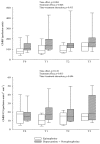Dopexamine and norepinephrine versus epinephrine on gastric perfusion in patients with septic shock: a randomized study [NCT00134212]
- PMID: 16507156
- PMCID: PMC1550826
- DOI: 10.1186/cc4827
Dopexamine and norepinephrine versus epinephrine on gastric perfusion in patients with septic shock: a randomized study [NCT00134212]
Abstract
Introduction: Microcirculatory blood flow, and notably gut perfusion, is important in the development of multiple organ failure in septic shock. We compared the effects of dopexamine and norepinephrine (noradrenaline) with those of epinephrine (adrenaline) on gastric mucosal blood flow (GMBF) in patients with septic shock. The effects of these drugs on oxidative stress were also assessed.
Methods: This was a prospective randomized study performed in a surgical intensive care unit among adults fulfilling usual criteria for septic shock. Systemic and pulmonary hemodynamics, GMBF (laser-Doppler) and malondialdehyde were assessed just before catecholamine infusion (T0), as soon as mean arterial pressure (MAP) reached 70 to 80 mmHg (T1), and 2 hours (T2) and 6 hours (T3) after T1. Drugs were titrated from 0.2 microg kg(-1) min(-1) with 0.2 microg kg(-1) min(-1) increments every 3 minutes for epinephrine and norepinephrine, and from 0.5 microg kg(-1) min(-1) with 0.5 microg kg(-1) min(-1) increments every 3 minutes for dopexamine.
Results: Twenty-two patients were included (10 receiving epinephrine, 12 receiving dopexamine-norepinephrine). There was no significant difference between groups on MAP at T0, T1, T2, and T3. Heart rate and cardiac output increased significantly more with epinephrine than with dopexamine-norepinephrine, whereas. GMBF increased significantly more with dopexamine-norepinephrine than with epinephrine between T1 and T3 (median values 106, 137, 133, and 165 versus 76, 91, 90, and 125 units of relative flux at T0, T1, T2 and T3, respectively). Malondialdehyde similarly increased in both groups between T1 and T3.
Conclusion: In septic shock, at doses that induced the same effect on MAP, dopexamine-norepinephrine enhanced GMBF more than epinephrine did. No difference was observed on oxidative stress.
Trial registration: ClinicalTrials.gov NCT00134212.
Figures



Comment in
-
The choice of catecholamines in septic shock: more and more good arguments to strengthen the known position, but don't lose the faith!Crit Care. 2006;10(2):127. doi: 10.1186/cc4859. Crit Care. 2006. PMID: 16563178 Free PMC article. Review.
References
-
- Hotchkiss RS, Karl IE. The pathophysiology and treatment of sepsis. N Engl J Med. 2003;348:138–150. - PubMed
-
- Dellinger RP. Cardiovascular management of septic shock. Crit Care Med. 2003;31:946–955. - PubMed
-
- Hollenberg SM, Ahrens TS, Annane D, Astiz ME, Chalfin DB, Dasta JF, Heard SO, Martin C, Napolitano LM, Susla GM, et al. Practice parameters for hemodynamic support of sepsis in adult patients: 2004 update. Crit Care Med. 2004;32:1928–1948. - PubMed
-
- Collins JL, Vodovotz Y, Yoneyama T, Hatakeyama K, Green AM, Billiar TR. Catecholamines decrease nitric oxide production by cytokine-stimulated hepatocytes. Surgery. 2001;130:256–264. - PubMed
-
- Koike K, Moore FA, Moore EE, Poggetti RS, Tuder RM, Banerjee A. Endotoxin after gut ischemia/reperfusion causes irreversible lung injury. J Surg Res. 1992;52:656–662. - PubMed
Publication types
MeSH terms
Substances
Associated data
LinkOut - more resources
Full Text Sources
Other Literature Sources
Medical
Miscellaneous

